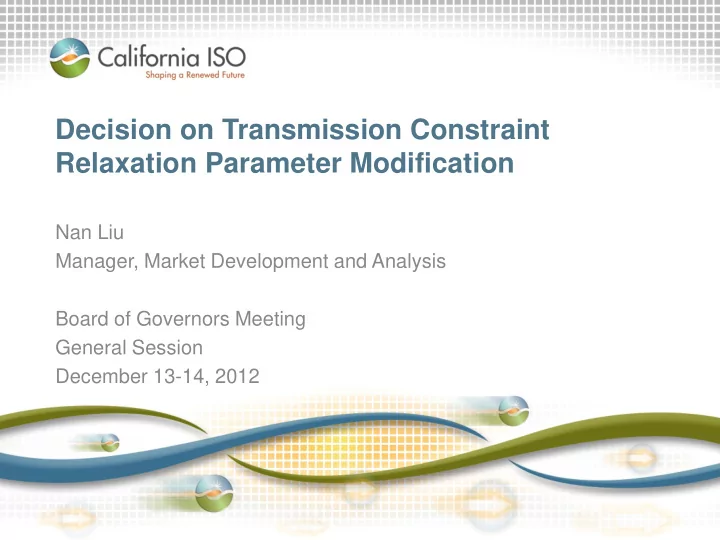

Decision on Transmission Constraint Relaxation Parameter Modification Nan Liu Manager, Market Development and Analysis Board of Governors Meeting General Session December 13-14, 2012
Transmission constraint parameter background: • Establishes reasonable limit on the extent to which effective bids are used to resolve congestion. • Similar parameters exist in all ISOs’ optimization software. • Current setting of $5,000 established in 2008 by the Board. – The ISO committed to revise if significant impact on market results. • Contributed to significant increase in real-time congestion offset costs that occurred in 3 rd quarter of 2012, due to: – Reductions of transfer capability in real-time vs. day ahead. – Increased price of congestion in real-time vs. day ahead. Slide 2
Real-Time congestion offsets allocated to load increased by a factor of five in 3 rd quarter. Real-time Congestion Offset $60,000,000 $50,000,000 $40,000,000 Since Q3 ~ $30M/month $30,000,000 3 rd Quarter increase in congestion offset cost $20,000,000 observed as real-time congestion increased $10,000,000 Average congestion offset cost prior to Q3 2012 ~ $6M/month $0 -$10,000,000 Real-time Congestion Offset Slide 3
Other contributing causes and actions to address increases in real-time congestion offset costs. Cause Action • Increased number of outages and binding • Improve outage coordination. constraints. • Increase cost impact transparency. • Physical upgrades. • Available dispatch options are • Limit the amount of constraint significantly limited in real time, 5 minute adjustment to available ramping interval. capability. • Address constraint in day ahead. • Unscheduled flow in real time. • Account for expected flow differences in the day ahead market. • Impose transmission reliability margin in hour ahead. • Convergence bidding increases the • Improve constraint modeling in day amount of transactions settled between ahead market. day ahead and real-time markets. • Increase constraint transparency. Slide 4
Convergence bidding contributes to the cost increase. Real Time Congestion Offset and Convergence Bidding Component $60 90% Millions 80% $50 70% $40 60% Percentage 50% $30 40% $20 30% 20% $10 10% $0 0% Jan Feb Mar Apr May Jun July Aug Sep Oct Nov Real-Time Congestion Offset Cost Contribution from Convergence Bidding Contribution of Convergence Bidding (%) Slide 5
Sensitivity analysis – significant reduction of real-time congestion offset cost when parameter is reduced with minimal impact on congestion relief. Transmission Reduction in real-time Observed reduction in constraint Relaxation congestion offset cost congestion relief: Parameter (Based on August 1- (13 real-time cases) October 22 results) $5000 N/A N/A $2500 18% 0-0.6% 0-5.0 1 % $1500 36% 0-5.0 1 % $1000 50% Note 1: Excluding an outlier, the reduction in relief observed is between 0% to 1%. In the outlier case, the 5% reduction is due to cuts of firm export that could not be cut unless the ISO was simultaneously curtailing ISO firm load. Slide 6
Stakeholder comments reflect supplier concerns and demand support. Position Comments Response Do not support: • Supplier revenue reduction • Convergence bidders benefiting the (Calpine, NRG, • Increase exceptional dispatch most with no physical relief WPTF, DC • Insufficient sampling size • Exceptional dispatch not expected to Energy) • Suggests change in increase based on insignificant relief. effectiveness threshold rather • Additional analysis performed, ISO than proposed parameter. commits to continuing to perform analysis. • Resource specific effectiveness threshold does not address ineffective dispatch of multiple resources. Support: • Some recommend reducing • Reducing to $1000 could result in (PG&E, SCE, to $1000 effective economic bids being ignored Six Cities, • Recommend changes in • Different allocation mechanism would Powerex, allocation of congestion offset require additional consideration. CDWR) costs. Slide 7
Comparison with other ISO/RTOs practices: ISO/RTO Comments SPP Price curve approach: 5 segments depending on loading/congestion. • $500 for loading between 100% to 101% • $750 for loading between 101% and 102% • $1000 for loading between 102% and 103% • $1250 for loading between 103% and 104% • $1500 if the loading is above 104% ERCOT • Base case or voltage violation: $5000 • N-1 contingency constraint violation: • $4500 for 354 kV • $3500 for 138 kV • $2800 for 69 kV ISO NE • Parameter not publicly available. • Constraint enforced in real time by exception based on conditions. MISO • $3,000 for Interconnection Reliability Operating Limit 500 kV constraints. • $2,000 for System Operating Limit constraint between 161kV and 500kV. • $1,000 for SOL constraint below or equal to 131kV. • $500 for SOL constraint below or equal to 69kV. NYISO • $4,000/MW. PJM • Parameter not publicly available. Slide 8
Summary of proposal • Reduce the transmission constraint relaxation parameter from $5,000 to $1,500 • Continue to pursue other enhancements that would improve consistency of congestion in the day-ahead and real-time • Consider tiered and constraint differentiated relaxation parameter modifications in the future Slide 9
Recommend
More recommend